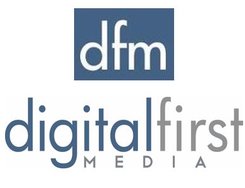Digital First Media is seeking a buyer. The second-biggest newspaper firm in the United States as measured by circulation says it is looking at strategic alternatives as it struggles to cope in a rapidly-changing world.
Headquartered in New York, Digital First Media (DFM) owns some well-known publications, including The Denver Post, The Los Angeles Daily News, The San Jose Mercury News, and The St. Paul Pioneer Press.
In June 2014, comScore ranked Digital First Media Number 8 in the General News category.
The company says its Board of Directors has embarked on a process to evaluate and consider strategic alternatives for the firm’s business.
DFM was formed through a merger of Media News Group and the former Journal Register Company in 2013. Today it has 800 multi-platform news and information products spanning 15 US states, which include 160 weekly publications and 76 daily/Sunday newspapers serving 75 million customers each month.
News information industry is changing
DFM’s CEO, John Paton, said:
“The news information industry in America is undergoing a period of seismic change, defined by the need to consolidate to rapidly compete in a digital world. The companies that will succeed are those which have meaningful scale and digital expertise.”
“By anticipating the rapid revolution in our industry and responding to stay ahead of the curve, DFM has clearly emerged as a leading player, based on the high quality of our assets and the extensive work we have done to transform them into multi-platform products that deliver outstanding local news and exceptional opportunities for advertisers.”
“As a result, we believe we have many options available to us to maximize the value of our businesses for our stockholders, and the Board of Directors has therefore decided to assess the full range of those opportunities.”

DFM looking at three options
DFM is considering the following strategic alternatives:
- The sale of the whole company,
- The sale of one or more regional clusters,
- Persevere with its current business plan.
Mr. Paton added that The Board is not limiting its considerations to just these three options.
DFM says there are currently no assurances that any of the processes will result in a transaction.
A struggling empire
Like many major newspaper companies today, DFM has been struggling to cope with a rapidly changing news information environment.
Over the past five years, The Journal Register Company, a former division which included The Trentonian and The New Haven Register, has filed for bankruptcy twice. It announced in April this year the shutting down of Project Thunderdome, a centralized newsroom that had been planned to provide articles nationwide and globally to its 75 newsrooms. More than fifty people were laid off.
Several major newspapers in the United States have been acquired over the last year:
- The Washington Post was bought by Amazon.com founder Jeffery P. Bezos for $250 million. The newspaper was founded in 1877 and is the most widely read in the Washington D.C. area.
- The Boston Globe, which belonged to the New York Times, was sold to John W. Henry, owner of the Boston Red Sox baseball team for just $70 million. Twenty years ago it had been acquired for $1.1 billion.
- Forbes Media was sold to Integrated Whale Investments which represents a Hong Kong-based group of international investors. Forbes announced in November 2013 that it was looking for a buyer.
- Newsweek was acquired by IBT Media in August 2013 from IAC/InterActiveCorp (IACI), a 100% digital company. Newsweek was once the second-biggest weekly journal in the United States after Time magazine.
The news information environment today and yesterday
The news information industry’s operating model that thrived with the invention of the steam press from 1830 until the end of the 20th century has been knocked on the head by the Internet.
Together with the birth of the Internet came mass media, which is principally supported by advertising.
Historically, the majority of print publications were sold at a loss. Journalists and editors created content and profits were achieved through advertising.
The Internet changed everything. Today, everybody can be a content-creator. The advertising market has opened up, and includes such giants as Google and Facebook, right down to the single blog owner hosting Google ads.
So far, online news content is mostly free. Some newspapers, such as the Financial Times, The Wall Street Journal, etc. are starting to charge a monthly subscription for online access.
Advertisers today use metrics to measure the effectiveness of their campaigns in ways that were not possible before.
Newspapers that did not respond rapidly to the change today are suffering, and will likely fall by the wayside.
Is the Internet killing traditional newspapers?
According to Pressor Matthew Gentzkow from the University of Chicago Booth School of Business, it is a fallacy to believe that traditional newspapers are being killed off by the Internet.
Professor Gentzkow said:
“This perception that online ads are cheaper to buy is all about people quoting things in units that are not comparable to each other – doing apples-to-oranges comparisons.”
As far as online advertising is concerned, Prof. Gentzkow explains, online advertising rates are typically discussed in terms of “number of unique monthly visitors” they can pull. In traditional print newspapers, circulation (how many people buy the paper) determines ad prices.
Studies have shown that the reader spends longer reading printed news than when online. When you compare how long each reader actually sees an ad, the price of attention for similar consumers is higher online, Gentzkow says.
In a study led by Prof. Gentzkow, the team concluded that the traditional newspapers that either died after the turn of the millennium or are struggling now were already in trouble before online news arrived.
From 1980 to 1995, before digital news became popular, printed newspapers’ popularity was already declining. Since 1995, the decline has continued at about the same rate.
